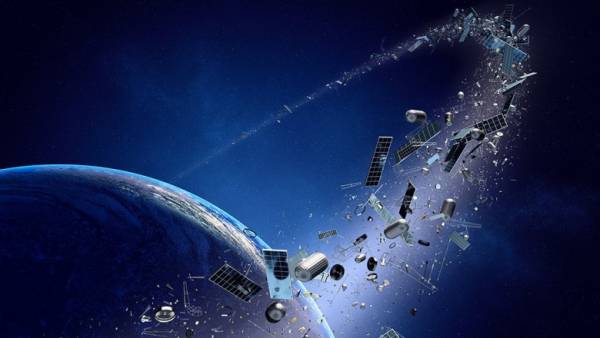Orbital garbage: how to effectively clean up space debris
MOSCOW, may 21 — RIA Novosti, Tatiana Pichugina. Russian satellite series “Canopus-V” has made two maneuver to avoid a piece of space debris. This incident attracted attention to the problem, which is already not the first decade of discussing experts: how to clean up near-earth space man-caused debris. RIA Novosti says about the perspective and the fantastic projects proposed by the scientific community.

Since the beginning of the space age about the Earth has accumulated a lot of objects flying at great speed near the satellites. If in near-earth space debris sooner or later slowed, falling and mostly burn up in the atmosphere, into geostationary orbit, they can spin forever. A collision with a small piece of plastic or iron at speeds of several kilometers per second faces of spacecraft destruction or serious damage.
In 1983, the bit of paint left a dent on the case of the American space Shuttle “Challenger”, 2006 space debris has damaged the thermoregulation of the Russian satellite “Express AM11”. From alien fragment with a size of just one centimeter damaged the antenna of the Hubble space telescope. ISS makes an average of five maneuvers per year to avoid debris. The satellite “Canopus” for the year for the same reason, changed orbit twice.
Now low earth orbit is almost a million man-made objects. Their weight is estimated at eight thousand tons.
Monitor also less than five percent, including spacecraft. According to the US, from Earth watch 18 thousands of space debris objects. The same information was voiced at the Council on space of Russian Academy of Sciences corresponding member of RAS Boris Shustov Institute of astronomy. According to him, fragments of the size in centimeter — a potential killer of spacecraft.
In addition, scientists are concerned about the accumulated debris with a large ratio of area to mass, because they are able to drastically change the orbit that are impossible to predict.
Dangerous and an annual fall of space debris to Earth. Although the trajectory could be calculated so that the collision with the surface occurs in desert areas, the probability of incidents is maintained.
Most space debris is formed due to the destruction and collision orbiters. In addition, orbit clog up the exhaust stage and boosters of boosters already inactive satellites, fragments, loose launches.
In the US, Russia and China have 93 percent of space debris.
Annually, its total volume increases by four percent.
Nets, sails and lasers
While the probability of collision with small debris, but sooner or later in orbit will have to restore order. Now limited to passive protection measures: place the satellites in the armor of the hull, set the flaps, or maneuvering in orbit. Active means of destruction there is no waste.
Nicolas Johnson (Nicholas Johnson), who oversees this issue at the NASA offered to launch into space is huge, with a diameter of 1.8 kilometers, the balloon NERF, filled with aerogel. Its porous shell will skip the small fragments to put out their speed, and as a result they will be burned up in the atmosphere. But the fact that the ball itself quickly descend from orbit and burn up. In addition, due to the large size of the high probability of its collision with existing spacecraft.
French engineer Jonathan Missel (Jonathan Missel) developed the satellite Sling-Sat with manipulator TAMU Space Sweeper. The machine unwinds like a sling, launches the chip in the direction where it is guaranteed entrance into the atmosphere. He himself goes to the next. This way of moving solves the problem of the large consumption of fuel for orbital robotic cleaners.